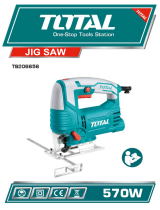
ENGLISHen
6
before making any adjustments, changing
accessories, or storing power tools. Such
preventive safety measures reduce the risk of
starting the power tool accidentally.
d) Store idle power tools out of the reach of
children and do not allow persons unfamiliar
with the power tool or these instructions to
operate the power tool. Power tools are
dangerous in the hands of untrained users.
e) Maintain power tools. Check for
misalignment or binding of moving parts,
breakage of parts and any other condition that
may affect the power tool's operation. If
damaged, have the power tool repaired before
use. Many accidents are caused by poorly
maintained power tools.
f) Keep cutting tools sharp and clean. Properly
maintained cutting tools with sharp cutting edges
are less likely to bind and are easier to control.
g) Use the power tool, accessories and tool bits
etc. in accordance with these instructions,
taking into account the working conditions and
the work to be performed. Use of the power tool
for operations different from those intended could
result in a hazardous situation.
2.5 Service
a) Have your power tool serviced by a qualified
repair person using only identical replacement
parts. This will ensure that the safety of the power
tool is maintained.
Hold the power tool by insulated gripping
surfaces, when performing an operation where
the cutting accessory may contact hidden
wiring or its own cord. Cutting accessory
contacting a "live" wire may make exposed metal
parts of the power tool "live" and could give the
operator an electric shock.
Use clamps or another practical way to secure
and support the workpiece to a stable platform.
Holding the work by hand or against your body
leaves it unstable and may lead to a loss of control.
Ensure that the place where you wish to work is free
of power cables, gas lines or water pipes (e.g.
check using a metal detector).
During work, the workpiece must lay flat and be
secured against moving, e.g. using clamps.
Do not try to saw extremely small workpieces.
When sawing, the footplate must make secure
contact with the workpiece.
When interrupting a cut for any reason, release the
trigger and hold the saw motionless in the material
until the saw blade comes to a complete stop. Never
attempt to remove the saw from the workpiece while
the saw blade is in motion or kickback may occur.
Do not switch the machine on while the saw blade is
touching the workpiece. Let the saw blade reach full
speed before making a cut.
When restarting a saw in the workpiece, centre the
saw blade in the kerf and check that saw teeth are
not engaged into the material. If the saw blade
seizes, it may kickback from the workpiece when
the saw is restarted.
Keep hands well away from the sawing area and the
saw blade. Do not reach underneath the workpiece.
Remove chips and similar material only with the
machine at a standstill.
Pull the plug out of the socket before making any
adjustments, converting or servicing the machine.
Danger of injury due to the sharp jigsaw blade. After
stopping work, the jigsaw blade may still be hot.
Wear protective gloves.
Additional Warnings:
California Prop 65 08_2018
Some dust created by power
sanding, sawing, grinding,
drilling, and other construction activities
contains chemicals known to cause cancer,
birth defects or other reproductive harm. Some
examples of these chemicals are:
• Lead from lead-based paints,
• Crystalline silica from bricks and cement and
other masonry products, and
• Arsenic and chromium from chemicallytreated
lumber.
Your risk from these exposures varies, depending
on how often you do this type of work. To reduce
your exposure to these chemicals: work in a well
ventilated area, and work with approved safety
equipment, such as those dust masks that are
specially designed to filter out microscopic
particles.
SYMBOLS ON THE TOOL:
.............Class II Construction
V.................volts
A.................amperes
Hz...............hertz
W................watts
~ ................alternating current
n
0
...............stroke rate at idle speed
spm ............stroke rate per minute
See page 2.
1 Clamping lever for securing the saw blade
2 Saw blade support roller
3 Saw blade (with lock-in shank (T-shank))*
4 Screw for adjusting the footplate
5 Footplate
6 Adjustment lever for pendulum motion
7 Anti-splintering footplate insert *
8 Saw blade clamping fixture
9 Protective rod for preventing unintentional
contact with the saw blade
10 Protective cap
11 Setting wheel for speed adjustment
12 Trigger switch
3. Special Safety Instructions
4. Overview
WARNING






